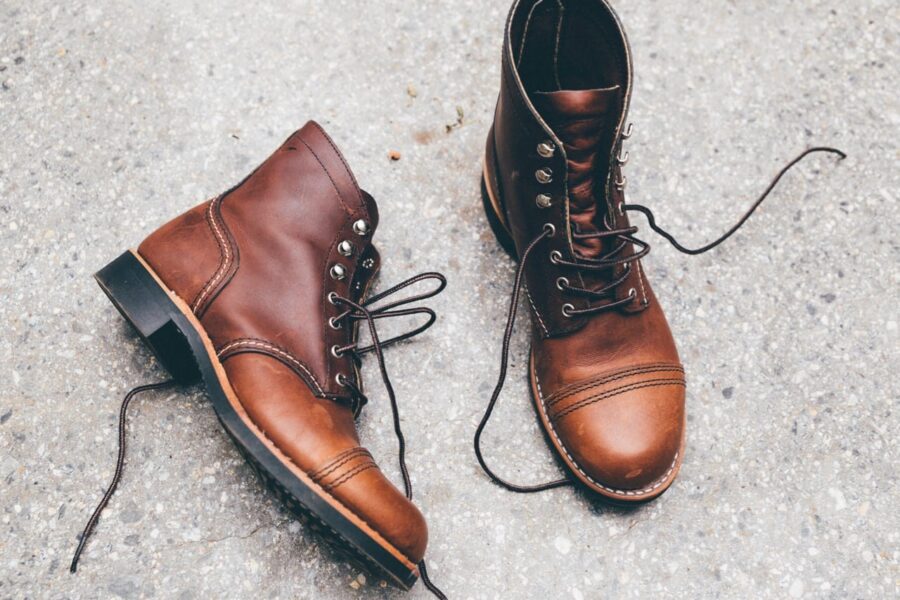This footwear class is generally meant to serve two major roles: to protect the feet and ankles and to bear the harshest environments for a considerable period of time. One could arguably add another one, which could possibly look more like a badass than just a mere complement of the first two.
Work boots come from manufacturers that will mostly sound familiar- Red Wing, Danner, Wolverine, and Chippewa. They are distinctive from your mall brand knockoffs, which might look similar but please don’t be fooled.
Go with cheap imitations and the linings will wear prematurely, the outsole will call for a replacement sooner than later and the purported leather uppers will crack. Not to mention the cheap look and substandard construction that makes your feet sweat.
Speaking of materials, buyers will generally find boots to be made of tough, oily fabric- as opposed to the thin, smooth leather of dress shoes. You don’t want to expect a sleek silhouette, elegant stitching, or elaborate perforations on such models.
Away from the need to look elegant, work boots can be chunky enough, which makes them practical. In fact, they almost always come with a rubber sole and more often than not are lugged.
Table of Contents
What About The Red Wing 877
Now let’s turn the focus to one of most people’s favorite choices, The Red Wing 877. To give a brief history, the 877 model was introduced in 1952 as a spot/hunting boot. Due to its comfort and toughness, the boot took the world by storm and soon outgrew its target audience.
The 8-inch Classic Moc is probably the most well-known boot in the Red Wing Heritage Collection. It is still made in Red Wing, Minnesota with the same commitment to materials and craftsmanship.
The iconic traction tread rubber outsole and Moc-toe construction stand out as the signature features of the boot. Moreover, the Puritan triple stitching and as well as the Goodyear welt ensure lasting durability.
Red Wing 877 Fit Information
Generally, a new pair of Red Wing Heritage boots should fit comfortably tight on the foot, providing enough room to freely wiggle toes. As you wear the boot, the full-grain leather upper, cork midsole, and the insole, will mold to your feet, providing an increasingly personalized fit over time. We always recommend trying on shoes in store to ensure a comfortable fit.
Speaking of the Red Wing 877, the oil-tanned uppers are fairly water-resistant, meaning they generally appeal to anyone spending a good amount of time outdoors including farmers and construction workers.
The crepe soles feature a very unique tread pattern. Rather than having massive lugs found on most boots of this type, Red Wing employs a more mild tread pattern.
Conventional heavy lugs usually become caked with mud and snow, making them heavy with little ability to grip on various surfaces.
Perhaps this outsole is what attracted most farmers and ironworkers. There are no protruding lugs to collect mud or snug on a bolt. Thus the boots are a natural fit for all kinds of work environments.
Users Experience
Based on reviews, the Red Wing 877 isn’t the best during the first month of wear. Indeed, they are painful to break in, just like anything built to last (that is, leather work gloves, raw denim, etc). Unfortunately, this is something most people aren’t used to in modern-day society.
The fact is that these boots aren’t a fashion statement meant to last one season and be swapped for the next newest tread.
They’re designed to withstand the rigors of the countryside and construction sites. In comparison, the cushy lightweight alternatives simply aren’t up to the task.
When you first get this footwear, the leather insole is hard, the leather uppers are stiff, and the unlined interior is nothing but an almost intolerable environment for your feet. But over time, maybe a month or two, the whole thing begins to break in.
Your feet will mold to the footbed as per your exact specifications. The uppers will become agreeably flexible whenever there’s movement but remains rigid when stuck. Soon enough, you’ll have a custom-made boot that is sure to last a considerable time as long as you care to keep them.
Red Wing 877 Break-in Tips
Wear them around even when you are not walking too much. The heat from your feet will help mold the leather foot. You might want to apply some oil to help speed the process. Most buyers use Red Wing all-natural boot oil made with mink oil and pine pitch.
You can also try crouching down on your toes with bent knees while watching TV or just checking around on the commuter. The point here is to flex the toes and the ankles. This way, you’ll get to soften up the two major points of movement. In fact, this is the most helpful break-in hack.
Another method, which is old and true, is to wear thick socks for the first few months to help ease the pain.
Red Wing 877: How to Wear Them
No doubt, Red Wings go great with jeans. You can also dress them up to a certain extent. Though it’s unlikely you’ll want to wear them to the office, you can still achieve a more dressy look, especially when you pair them with heavier fabrics and patterns.
Red Wing 877 Work Boot Options
While we’re a big fan of the Red Wing 877, there’s always a number of great work boot options that serve just as well. Bearing in mind that reliable work boots usually cost around $200 to $300, the model listed below will hardly present different price points.

